Micro Scale Thermophoresis is used to measure binding affinities in solution in capillaries, using only a small amount of sample. The applications range from small-molecule binding events to protein-protein interactions and interactions within complex macromolecular assemblies. MST can be performed both with extrinsic fluorescent labels (Monolith NT.115, NanoTemper) or intrinsic fluorescence (Monolith NT.LabelFree instrument, NanoTemper).
What are the sample requirements?
- Pure samples are required and concentrations should be determined accurately.
- Purity is critical for covalent amine labelling since all primary amines will be labelled including those present in any contaminants. Whenever possible, non-covalent labelling of His tags is preferred.
- Approx. 200 µL of the labelled target (at a concentration allowing a sufficient fluorescence signal to be measured) is needed per titration.
- 20-50 µL of the unlabelled ligand molecule is required per titration, at a concentration 20-100 fold above the expected Kd.
What other specific considerations are relevant?
- MST optimized buffer: 50 mM Tris pH 7.4, 150 mM NaCl, 10 mM MgCl2, 0.05 % Tween-20 or 0.1 % Pluronic F 127. Alternatively PBS with 0.05 % Tween-20.
- For the protein labelling, commercially available labelling kits are used (amine, Cys or His-tag reactive).
- For information about the types of capillaries and labelling kits available, please check with the TNA site.
- Concentration of unlabelled protein to use with a labelling kit: 100 μl of 200 nM (His-tag dye), 100 μl of 2–20 µM (amino-reactive and maleimide-reactive dyes).
Partners offering this technique
MOSBRI reference partner site for this technique:
Other partners:
